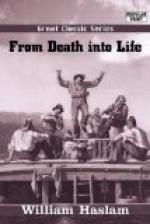The people were much pleased with their church in its new aspect, and brought their friends and neighbours to see it. Besides this, I observed something which gratified me very much. It was that when they entered the church they did so with reverence, taking off their hats and walking softly, in place of stamping with their heels and coming in with their hats on, as they too often had previously done, without any respect or concern whatever. A neglected place of worship does not command reverence.
My church now began to be the talk of the neighbourhood. Numbers of people came to see it, and among them several clergymen, who asked me to come and restore their churches.
There were many places where the people could not afford to rebuild the structure. In such, I was invited to exercise my skill in repairing, as I had done with my own; in others, I was asked to give designs for restoring portions of the edifice; and in some, for rebuilding altogether. In this district, schools were not built nor parsonage-houses enlarged without sending for me.
For several years I was looked upon as an authority in architectural matters. I rode about all over the county from north to west, restoring churches and designing schools, and was accounted the busiest man alive; and my horse, my dog, and myself, the “three leanest things in creation,” we were to be seen flying along the roads, day and night, in one part or another.
The Bishop of Exeter, who at that time presided over Cornwall, appointed me to make new “Peel” districts.* I designed nineteen, and made all the maps myself, calling on the Vicars and Rectors for their approbation. I was at this time a very popular man, and it was said that “the Bishop’s best living” would be given to me in due time.
_____________
* The “Peel” districts were the new ecclesiastical districts created under the Church Extension Act, introduced by Sir Robert Peel. _____________
CHAPTER 4
Antiquarian Researches and Ministry, 1843-6.
Another thing which raised my name in and beyond the county was the “Lost Church” at Perranzabuloe. There was an old British church existing in some sand-hills in the parish, and it was said to be entire as far as the four walls. The hill under which it was buried was easily known by the bones and teeth which covered it. The legend said that the patron saint, St. Piran, was buried under the altar, and that close by the little church was a cell in which he lived and died. This was enough. I got men, and set to work to dig it up. After some days’ labour we came to the floor, where we discovered the stone seats, and on the plaster of the wall the greasy marks of the heads and shoulders of persons who had sat there many centuries ago. We found the chancel step, and also the altar tomb (which was built east and west, not north and south). It was fallen, but enough remained to show the original shape and height of it.




